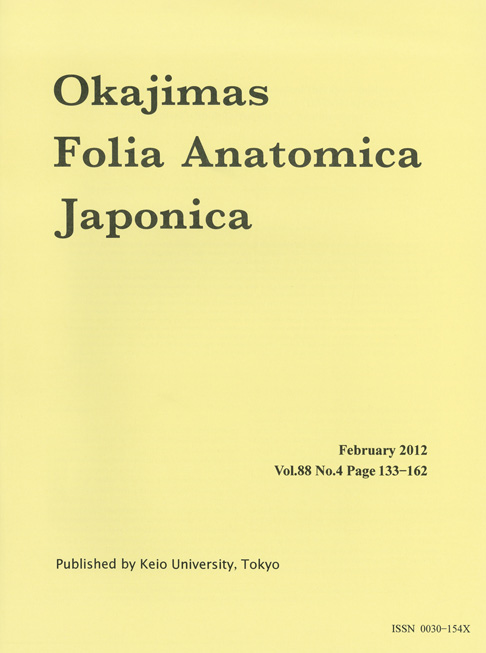All issues

Volume 66 (1989 - 199・・・
- Issue 6 Pages 301-
- Issue 5 Pages 229-
- Issue 4 Pages 153-
- Issue 2-3 Pages 61-
- Issue 1 Pages 1-
Predecessor
Volume 66, Issue 1
Displaying 1-6 of 6 articles from this issue
- |<
- <
- 1
- >
- >|
-
Masahiko KIDA, Hajime ISHIDA1989 Volume 66 Issue 1 Pages 1-11
Published: 1989
Released on J-STAGE: September 24, 2012
JOURNAL FREE ACCESSA rare muscle variation belonging to the forearm flexor muscle group has been observed in three forearms out of nearly 200 Japanese cadavers. It arose from the well developed fascia of the superficial forearm flexor group, crossed the median nerve obliquely and posteriorly lying radial to that nerve, and was inserted into the flexor retinaculum. The muscle variations in the three cases were discussed according to the concept of "corrected" nerve-muscle specificity and conservative morphology. They were conclusively ascribable to the original antebrachial flexor group of Yamada. This seemed to indicate that the variations were related or identical to Gantzer's muscle, and that they showed a possible original or archaic pattern of the original antebrachial flexors.View full abstractDownload PDF (2187K) -
Proportions in Their LengthsKatsutomo KATO, Tamotsu OGATA1989 Volume 66 Issue 1 Pages 13-22
Published: 1989
Released on J-STAGE: September 24, 2012
JOURNAL FREE ACCESSThe proportional relationships among the lengths of main limb bones comprising the humerus, radius, tibia and femur of the Jomon people are examined by means of comparison with those of the Kofun and recent Japanese. The disto-proximal indices (the radio-humeral and libiofemoral)of the Jomon are significantly greater than those of the comparison ages, but the humero-femoral index, as a intermembral, is significantly smaller. Logarithmic plots showing the relation between each two bones, indicate no significant age differences among the inclinations of regression lines corresponding to allometry coefficients. However, significant age differences among the levels of lines were found. According to previous studies, there may be two factors affecting the proportions among limb segments, one biomechanical and the other thermal. The adaptation to mode of life, such as hunting of quick moving animals, appears to be a more reasonable interpretation of the relatively long distal segments (high disto-proximal indices) of the Jomon people.View full abstractDownload PDF (1958K) -
Kazutaka OHSAWA, Takao NISHIDA, Masamichi KUROHMARU, Yoshihiro HAYASHI1989 Volume 66 Issue 1 Pages 23-37
Published: 1989
Released on J-STAGE: September 24, 2012
JOURNAL FREE ACCESSThe chicken m. retractor phalli cranialis classified as a smooth muscle was examined by electron microscopy to study the innervation of this muscle using the dichromate/chromate fixation method for demonstration of biogenic amines (Tranzer and Richards,1976). Approximately two axon complexes per 100 muscle cells were found in both sexes. The axon varicosities were divided into the following four types; varicosities with,1) small clear vesicle and chromaffin-negative large granular vesicle (cholinergic),2) chromaffin-positive,6-hydroxydopamine (6-OHDA) susceptible small and large granular vesicle (adrenergic),3) chromaffin-positive,6-OHDA resistant pleomorphic and large granular vesicle (aminergic?), or 4) chromaffin-negative large opaque vesicle (peptidergic?). These results suggest that non-adrenergic, non-cholinergic nerve may also play an important role in the innervation of m. retractor phalli cranialis as well as of the smooth muscle in mammalian intestine.View full abstractDownload PDF (3693K) -
Kengo KAJIWARA1989 Volume 66 Issue 1 Pages 39-51
Published: 1989
Released on J-STAGE: September 24, 2012
JOURNAL FREE ACCESSDetailed investigations were made of the microvasculature of the mucous membrane, especially the transverse palatine plicae, of the hard palate of the Japanese monkey (Macaca fuscata)utilizing the plastic injection method. The microvascular patterns obtained were compared with those of the cat and other mammals. The incisive papilla was located at the anterior end of the median line of the hard palate, and seven or eight transverse palatine plicae were observed symmetrically from this papilla posteriorly at similar intervals. Each plica arched bilaterally in a wide M. The heights of the plicae decreased gradually at their lateral ends. The whole palate was supplied by two arteries. The minor palatine artery supplied the soft palate and the major palatine passed forwards to supply the hard palate, sending off numerous, medial and lateral branches. The plical branches diverging from both these branches formed a primary arterial network (submucous arterial network), and arterioles diverging superiorly from this network formed a second arterial network (arterial network in the lamina propria). Fine twigs diverging from the latter network formed a subepithelial capillary network immediately beneath the epithelium. Capillary loops sprouted out of the above network in the lamina propria. The descending crus of each loop drained via the subepithelial capillary network of the venous side into a venous network located in the same layer as the arterial network. These vessels finally drained into the submucous venous network (palatine venous plexus). In conclusion, the transverse palatine plicae in M. fuscata were formed from a thickening or eminence of the lamina propria, as opposed to the submucous tissue in the cat. Accordingly, the presence of such submucous tissue has been not observed in M. fuscata except in a limited area of the hard palate. The microvascular patterns of the hard palate of M. fuscata were similar to those of the cat.View full abstractDownload PDF (3999K) -
Kazuyuki SHIMADA, Tadashi KITAGAWA, Masaharu TEZUKA1989 Volume 66 Issue 1 Pages 53-56
Published: 1989
Released on J-STAGE: September 24, 2012
JOURNAL FREE ACCESSA supernumerary valvula of the pulmonary semilunar valve was found in a 51-year old, male Japanese. The valve was composed of three equal-sized valvulae and one smaller one with numerous fenestrations present. The supernumerary valvula was located between the anterior and right valvulae. We found this condition in one of 1407 cadavers examinedView full abstractDownload PDF (1168K) -
Sanae ICHIKAWA, Shigeo UCHINO, Yukio HIRATA1989 Volume 66 Issue 1 Pages 57-59
Published: 1989
Released on J-STAGE: September 24, 2012
JOURNAL FREE ACCESSDownload PDF (1627K)
- |<
- <
- 1
- >
- >|